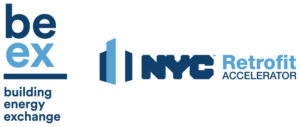Packaged Terminal Heat Pumps (PTHPs)
Decentralized electric heating and cooling for multifamily buildings.
Tech Overview
Applicable Buildings Types all multifamily, hotels
When to Implement at time of equipment replacement, at tenant overturn
*Be sure to consult a qualified service provider to determine the right measures for your building.
What are Packaged Terminal Heat Pumps (PTHPs)?
Package Terminal Heat Pumps (PTHPs) are a decentralized air-source heat pump (ASHP) technology that can be used to heat and cool spaces in multifamily buildings. PHTPs are compact and efficient, reducing greenhouse gas emissions, and offer buildings a path to electrification and energy savings.

Fig 1. (Left) Outdoor view of PTHP. Fig 2. (Right) Indoor view of PTHP.
How to Implement
The best time to implement a PHTP upgrade is during a window and facade renovation, or at the time of heating and cooling equipment replacement. Download the full tech primer to learn more about each of the following steps:
A. Install PTHPs in wall openings with correctly sized metal sleeves for a proper air seal that minimize air leaks
B. Control Condensate by properly draining after defrost cycles and as the room is dehumidified
C. Install Remote Room Temperature Sensors to assist internal PTHP temperature in providing an accurate room temperature reading
Cost and Benefits
Cost and benefits of packaged terminal heat pumps (PTHPs) systems will vary depending on your building’s baseline systems and conditions. Typically, buildings can expect to see the following results:
Greenhouse Gas (GHG) Savings
Converting a multifamily building to PTHPs can greatly reduce heating and cooling related GHG emissions.
Tenant Experience Improvement
Tenant experiences will remain largely unchanged, however proper installation of PTHPs will improve the air tightness, which reduces drafts and improves comfort.
Utility Savings
Although PTHPs consume significantly less energy than systems that use natural gas, fuel oil, or district steam, utility cost for operating PTHP can be high due to the current cost of electricity.
Capital Cost
The capital cost of conversion to PTHPs are moderate for building with existing PTACs.
Maintenance Requirement
A properly installed PTHP system requires a moderate level of maintenance, usually involving cleaning and replacing air filters.
Take Action
This information is part of more than a dozen High Performance Technology Primers prepared by the Building Energy Exchange and the Retrofit Accelerator to introduce decision-makers to solutions that can help them save energy and improve comfort in their buildings. Curious about other retrofitting possibilities? Explore our complete library of Tech Primers here.
The NYC Retrofit Accelerator’s team of Efficiency Advisors offers free, personalized advisory services to help streamline the process of making energy efficient improvements to your buildings.
Get in touch with the NYC Retrofit Accelerator today!
Call (212) 656-9202
Visit nyc.gov/RetrofitAccelerator
Email info @nycretrofit.org
